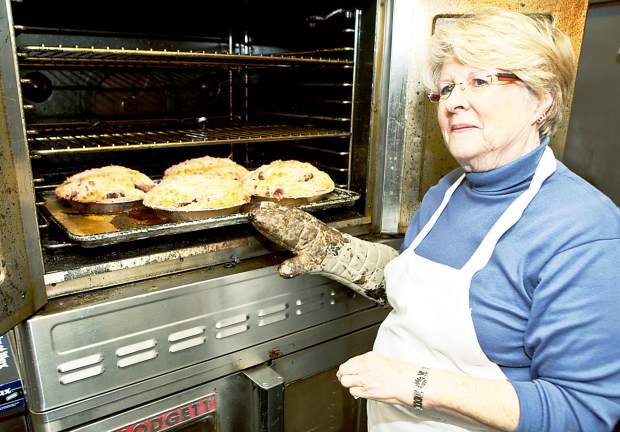Farm family’s ancestral pie recipes surviving scratch baking decline

Once upon a rural time, window sills across the U.S. were dotted with pies.
Covered with mesh domes or clean dish towels, they stoically awaited their sweet fate as treats for chore-weary farm families.
Some of those spherical beauties were ultimately topped with homemade ice or whipped cream. Adorned with some dairy delight or plain and simple, pies buoyed American farmers and ranchers during dust bowl summers or cabin fever winters.
Folks didn’t just want pie, they needed pie!
Most farm families were large, with ‘little old woman who lived in a shoe’ head counts.
Therefore, the American pie safe became a common piece of furniture in rural kitchens, dating back hundreds of years.
The decorative cupboards sported pierced tin doors for ventilation. Air, but not pests, could circulate freely, thus cooling and preserving baked goods. Latched doors slowed attacks by hungry kiddos. Pie safes provided deserts a happy, secure waiting area.
County and state fairs welcomed pies, in “Best of” competitions, or as targets for snapping jaws determined to consume more than could their rivals.
Serious eating contests required a plethora of pies to provide dribble-down ooze on determined gobblers’ chins.
Even today, many index card boxes (or computerized files) contain one or two of Grandma’s hand-me-down pie recipes. Even if re-created only once a year, or decade, family pride swells when their edible heirloom is served up at some special gathering.
Sadly, with interest in home baking dwindling, many dog-earred cookbooks or stuffed recipe boxes end up at estate sales or thrift stores when owners pass on.
Online exploration for recipes’ origins yield labels such as “Someone’s Grandma’s Cherry Pie.”
Surviving or reproduction pie safes are rarely used for their intended purpose.
Computer printer paper stored in granny’s pie safe? Sacrilege!
•
Take a deep, cleansing breath and exhale.
Then, load up the kiddos and head to Estes Park, Colo. This Rocky Mountain National Park town has another treasure tucked away amongst historic sites.
One resident not only knows the origins of her grandma’s pies, but bakes dozens of them daily for eager visitors to enjoy.
Val Thompson has always been a pie lover. At age 10, her parents relocated from Arizona to Estes Park. She eventually travelled for employment but moved home to Estes in 2004. She soon realized something was missing in her childhood town. To appease sugar-deficient locals and tourists, Estes Park had only candy stores and a donut shop, but no bakery.
Not only did Thompson have oodles of family recipes, she knew the “who,” “what,” “when” and “where” of each. Stepping back into her pies’ pasts, she recalled paternal grandmother Rose Laffoon, who grew up on a Colorado crop farm in miniscule Woodsow, 20 miles south of Brush. Grandma Rose’s father, Cameron, had moved there from Missouri to homestead (circa 1900-teens). Once the farm was up and running, he became an evangelical preacher who traveled and taught all around the eastern plains. He and wife Hattie, a German immigrant, had five offspring, all girls.
Rose was the Laffoons’ eldest daughter. Perhaps that primary position gave her a place of honor at her mother’s elbow in the kitchen; there she learned to prepare German foods, including baked goods.
She treasured and preserved those recipes, carrying them into marriage with Loveland native Dan Smith. Their first-born, Dan Jr., grew up, married Alix Kyle, and fathered Val Thompson.
When Thompson (then Smith) was just 10-years-old and residing in southern Arizona, she began learning to prepare the Laffoon recipes under the tutelage of mother Alix and Grandma Rose. (To assure her son Dan Jr. would be well-fed, Rose had quickly taught daughter-in-law Alix to cook, recalled Thompson with a chuckle).
Her genealogy thoroughly saturated with baking and cooking ingredients, and poor Estes Park suffering from a homemade baked goods shortage, Thompson took the stirring spoon into her own hands and, in 2006, opened the Estes Park Pie Shop.
Like yeasty dough, the little bakery quickly grew.
In 2013, it enlarged and moved just up the street to 509 Big Thompson Avenue in Lower Stanley Village where Thompson focuses on food, customer service and business decisions, in that order. Her motto is posted in many places around the shop: “WGBP”, which reminds employees to always ask themselves, “Would Grandma be Proud?”
“Baking from scratch is a lost art,” Thompson dolefully declared. But her shop serves as a beacon in that doughy darkness. “People are amazed,” she said of her homemade delights. “They insist my pies taste just like their grandmas’ pies!”
It takes a lot of energy and prep time to engineer that magic.
A typical day at the shop begins at 3:30 AM, when multitudinous mixing commences. Fifty crusts at a time move from pie presses to tins. Next, add the fillings for six to eight fruit pies of each variety. No shortage in this medley; among the 40 fruit selections are top-selling strawberry rhubarb, cherry peach, caramel apple pecan and triple berry.
Evolving from Grandma Hattie’s slow-cooked custard recipe are coconut cream, chocolate cream, banana cream and more. Newly added, albeit generations-old, are s’mores and French Silk.
The hardy ovens can handle up to 24 pies at once; in peak season, summer, 100 pies per day enter the world, mostly by the skilled hands of Thompson and mom Alix. After three oven hours, breads, cookies, brownies, scones, cinnamon rolls and sticky buns take the kitchen spotlight.
The ingredient amounts are astounding. During an average week, 500 pounds each of flour and sugar combine with 2300 eggs in a marriage made in sweet-tooth heaven.
With the 2013 move, the original walk-up bakery became a 55-seat capacity, 1950’s-themed bakery/restaurant with dining room and outdoor patio. While oldies tunes play, eager patrons enjoy not only baked goods, but also main courses.
The breakfast (served all day) menu features homemade biscuits and gravy, flapjacks, and three-egg scrambles. Moving clock hands forward, diners select from soups and chili and burgers and sandwiches– bread and buns homemade. Thompson uses local products whenever possible, including eggs, fruit, and Front-Range raised beef. Estes Park Pie Shop is better-known by its tagline. Perhaps eager patrons’ shared proclamation drives that happy misnomer but, regardless, it actually covers more of the signage than does its given name.
Thompson declared that, when asked the normal question, “May I help you?,” a preponderance of visitors respond, “I need pie!” And so, Estes Park Pie Shop signage affirms: “You Need Pie!”
One recent guest agreed. Evans, COLO., resident Linda Parker had heard good things about the pies. So, on a recent trip to Estes Park, she stopped in and selected the caramel apple pecan. Quizzed for a review, and recalling its taste on her happy buds, she simply replied, “Fabulous!”
For four-five months per year, a huge tourist base monopolizes the shop’s tables.
A great year-round local following and Holiday shipping via http://www.youneedpie.com, (970) 577-PIES, further drives the success of a business that began a hundred years ago in a humble homesteaders’ kitchen on Colorado’s eastern plains, and before in far-distant Germany.
Simple deserts prepared from basic ingredients by hard-working farm folks have stood the test of time. Generations have passed, their primitive buildings are gone, and yet people today still enjoy the bounty of their recipes. If asked why, Val Thompson’s ancestors would likely answer, “Because you need pie!”
It’s true, you do. You need pie.
And Grandma would be proud. ❖








